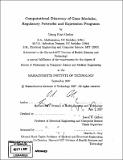| dc.contributor.advisor | David K. Gifford. | en_US |
| dc.contributor.author | Gerber, Georg Kurt, 1970- | en_US |
| dc.contributor.other | Harvard University--MIT Division of Health Sciences and Technology. | en_US |
| dc.date.accessioned | 2008-09-03T14:52:40Z | |
| dc.date.available | 2008-09-03T14:52:40Z | |
| dc.date.copyright | 2007 | en_US |
| dc.date.issued | 2007 | en_US |
| dc.identifier.uri | http://hdl.handle.net/1721.1/42201 | |
| dc.description | Thesis (Ph. D.)--Harvard-MIT Division of Health Sciences and Technology, 2007. | en_US |
| dc.description | Includes bibliographical references (p. 163-181). | en_US |
| dc.description.abstract | High-throughput molecular data are revolutionizing biology by providing massive amounts of information about gene expression and regulation. Such information is applicable both to furthering our understanding of fundamental biology and to developing new diagnostic and treatment approaches for diseases. However, novel mathematical methods are needed for extracting biological knowledge from high-dimensional, complex and noisy data sources. In this thesis, I develop and apply three novel computational approaches for this task. The common theme of these approaches is that they seek to discover meaningful groups of genes, which confer robustness to noise and compress complex information into interpretable models. I first present the GRAM algorithm, which fuses information from genome-wide expression and in vivo transcription factor-DNA binding data to discover regulatory networks of gene modules. I use the GRAM algorithm to discover regulatory networks in Saccharomyces cerevisiae, including rich media, rapamycin, and cell-cycle module networks. I use functional annotation databases, independent biological experiments and DNA-motif information to validate the discovered networks, and to show that they yield new biological insights. Second, I present GeneProgram, a framework based on Hierarchical Dirichlet Processes, which uses large compendia of mammalian expression data to simultaneously organize genes into overlapping programs and tissues into groups to produce maps of expression programs. I demonstrate that GeneProgram outperforms several popular analysis methods, and using mouse and human expression data, show that it automatically constructs a comprehensive, body-wide map of inter-species expression programs. | en_US |
| dc.description.abstract | (cont.) Finally, I present an extension of GeneProgram that models temporal dynamics. I apply the algorithm to a compendium of short time-series gene expression experiments in which human cells were exposed to various infectious agents. I show that discovered expression programs exhibit temporal pattern usage differences corresponding to classes of host cells and infectious agents, and describe several programs that implicate surprising signaling pathways and receptor types in human responses to infection. | en_US |
| dc.description.statementofresponsibility | by Georg Kurt Gerber. | en_US |
| dc.format.extent | 181 p. | en_US |
| dc.language.iso | eng | en_US |
| dc.publisher | Massachusetts Institute of Technology | en_US |
| dc.rights | M.I.T. theses are protected by
copyright. They may be viewed from this source for any purpose, but
reproduction or distribution in any format is prohibited without written
permission. See provided URL for inquiries about permission. | en_US |
| dc.rights.uri | http://dspace.mit.edu/handle/1721.1/7582 | en_US |
| dc.subject | Harvard University--MIT Division of Health Sciences and Technology. | en_US |
| dc.title | Computational discovery of gene modules, regulatory networks and expression programs | en_US |
| dc.type | Thesis | en_US |
| dc.description.degree | Ph.D. | en_US |
| dc.contributor.department | Harvard University--MIT Division of Health Sciences and Technology | |
| dc.identifier.oclc | 230820346 | en_US |
